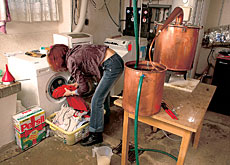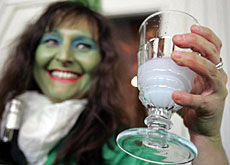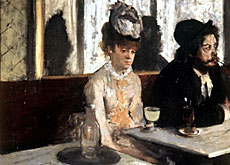Absinthe bootleggers refuse to go straight

A year after the Swiss authorities lifted a century-old ban on absinthe, dozens of bootleggers are continuing to produce the liquor in clandestine distilleries.
The Swiss Alcohol Board (SAB) made a number of busts over the winter but says tracking the illegal stills remains tough.
The sale and production of absinthe has been legal in Switzerland since March 1 last year and figures released by the SAB this week show that the “Green Fairy” has taken wing.
Almost 130,000 litres have been produced over the past 12 months, with 90 per cent flowing from the historic heartland of Swiss absinthe, the Val-de-Travers in the northwest of the country.
The SAB has handed out eight licences, most of them to former bootleggers in the Val-de-Travers area. But it is estimated that up to 35 illegal distillers are still holding out.
Marc Gilliéron, head of the SAB’s distillery operations for western Switzerland, says this principally down to two reasons: tax evasion and keeping the outlaw spirit alive.
“Following the lifting of the ban there was a big debate among the people of the Val-de-Travers and many said that by making absinthe legal the mystique had gone,” Gilliéron told swissinfo.
“I think this may have encouraged many bootleggers to carry on the tradition of operating outside the law.”
Financial rewards
But the romantic image of bootleggers staying one step ahead of the law ignores the fact that considerable sums of money are at play.
An illegal distillery producing several thousand litres of absinthe a year can pocket serious cash, especially if it procures the pure alcohol it needs at a knock-down rate abroad. In Switzerland, a litre of pure alcohol carries a SFr29 ($22) duty.
The SAB says it has no idea how many illegal producers are still out there but points to the half dozen winter raids as evidence that business continues to flourish.
And as was the case before the lifting of the ban, the absence of tip-offs from inside the close-knit community means the SAB’s inspectors have to get by on meagre scraps of information.
“In the Val-de-Travers there is a code of silence surrounding absinthe, so we have to get our information from outside the community,” said Gilliéron. “I think most of the residents know who the illegal producers are but no one ever gives up an address or name.”
Wall of silence
Whether lips stay sealed for much longer is open to question. Some legal distillers are said to be annoyed that some of their former comrades continue to profit illegally while they play ball.
“This rebel streak has always been part of the Val-de-Travers and in this respect we have to accept there will be illegal distillers,” said Julien Spacio, general secretary of the local absinthe producers’ association.
“But it’s clear that some producers who now have a licence see certain bootleggers as competitors.”
“All depends on the size of the operation,” he added. “Those who are doing it for personal use, friends and neighbours should be left alone. But as soon as a bootlegger crosses certain production limits he should come clean and apply for a licence.”
Spacio, who believes that there are still around 35 bootleggers in the Val-de-Travers, strongly denies that his association would ever grass on illegal distillers. But he added that he was not responsible for the actions of his members.
As for the burning question of which is the real McCoy – legal or illegal absinthe – both the SAB and the local producers’ association dismiss the view that the regulated brew is a pale imitation of the bootleg variety.
“The same method is used as in the past and it allows for a maximum of 35 milligrams per kilogram of thujone [the toxic substance found in wormwood, absinthe’s main flavouring ingredient]. We often find illegal distilleries use a lot less than this,” said Gilliéron.
swissinfo, Adam Beaumont
Swiss voters banned the sale and production of absinthe in 1908.
One version of the origins of absinthe says that it was first discovered in around 1740 by Henriette Henriod in canton Neuchâtel.
Another account says it was invented by Dr Ordinaire – a Frenchman exiled to Switzerland for political reasons – in 1792.
If caught by the SAB, bootleggers face having their equipment seized and fines running into tens of thousands of francs. The SAB has a three-strong team of inspectors covering the whole of western Switzerland.
An amnesty allowing illegal distillers to come clean and apply for a licence will remain in place until the end of the year.
To qualify for a licence, a distillery or group of distillers has to produce at least 500 litres of absinthe a year. Four former bootleggers formed a cooperative to qualify for a licence.
An application for a Protected Designation of Origin (AOC label) for absinthe is being examined by the Federal Agriculture Office.

In compliance with the JTI standards
More: SWI swissinfo.ch certified by the Journalism Trust Initiative


You can find an overview of ongoing debates with our journalists here. Please join us!
If you want to start a conversation about a topic raised in this article or want to report factual errors, email us at english@swissinfo.ch.